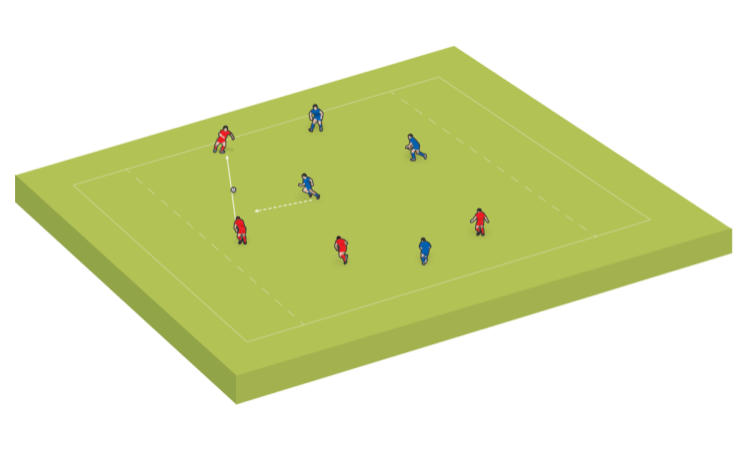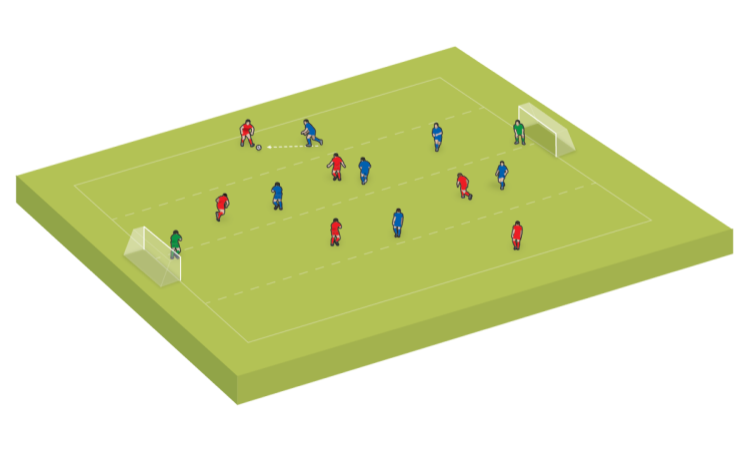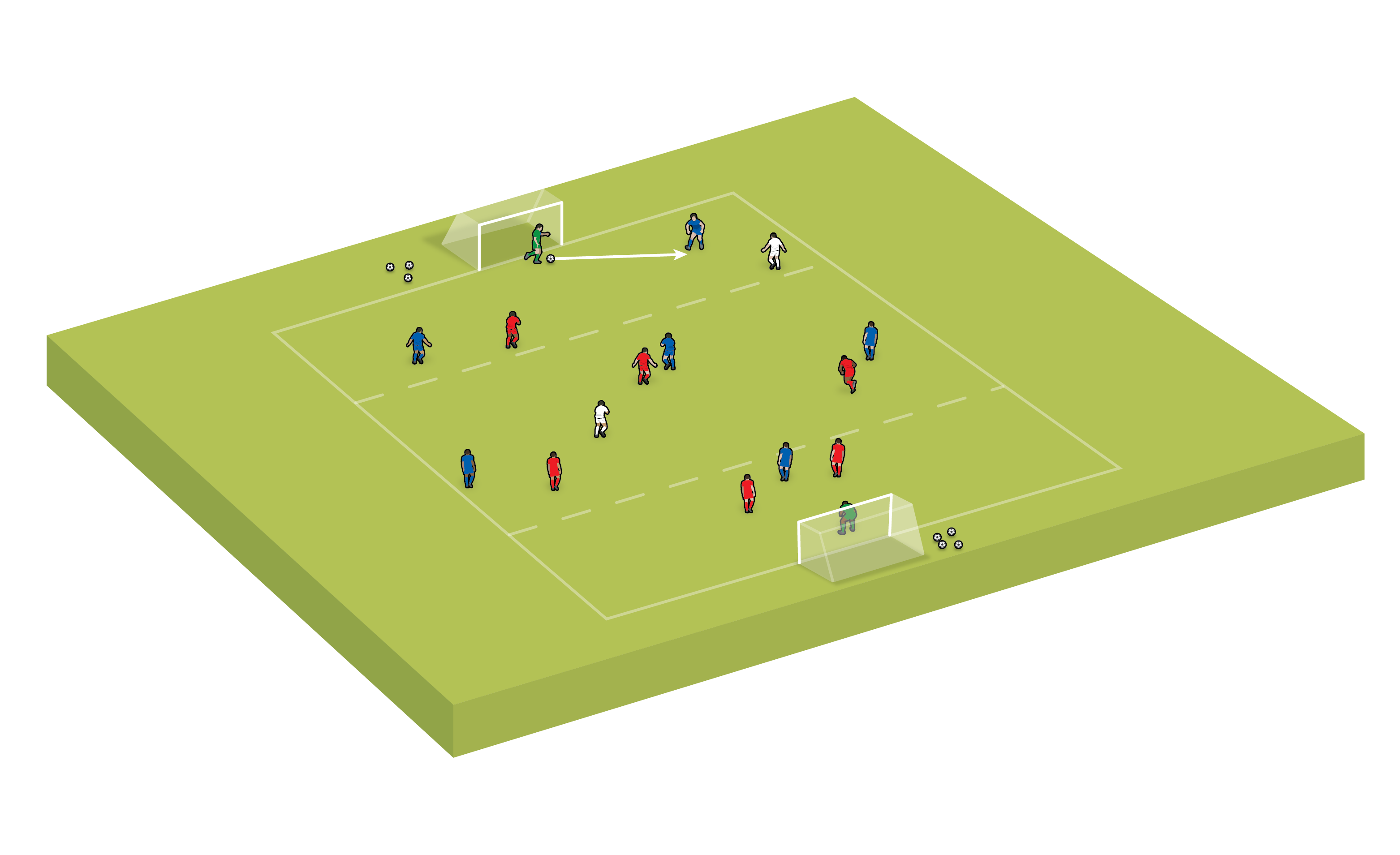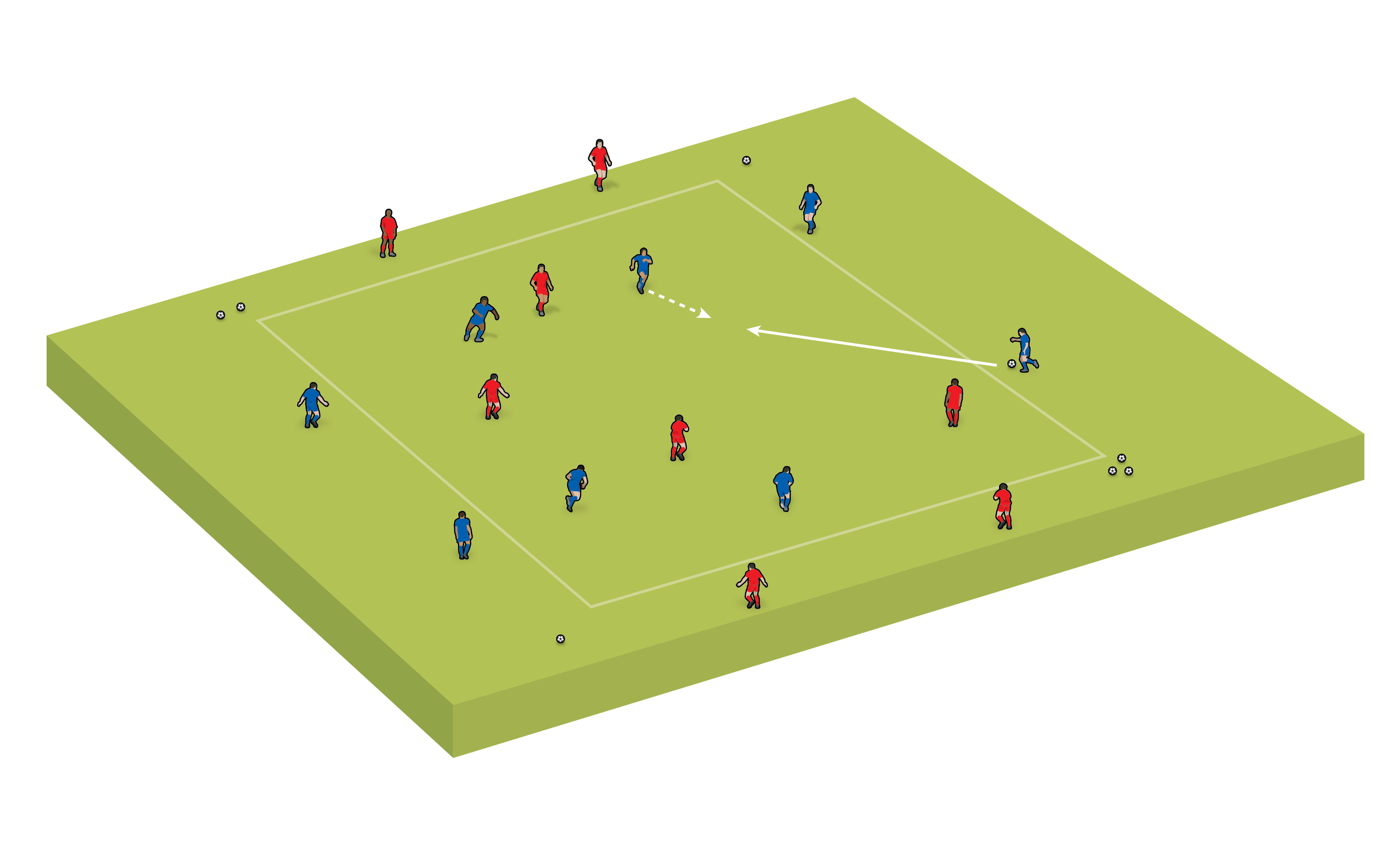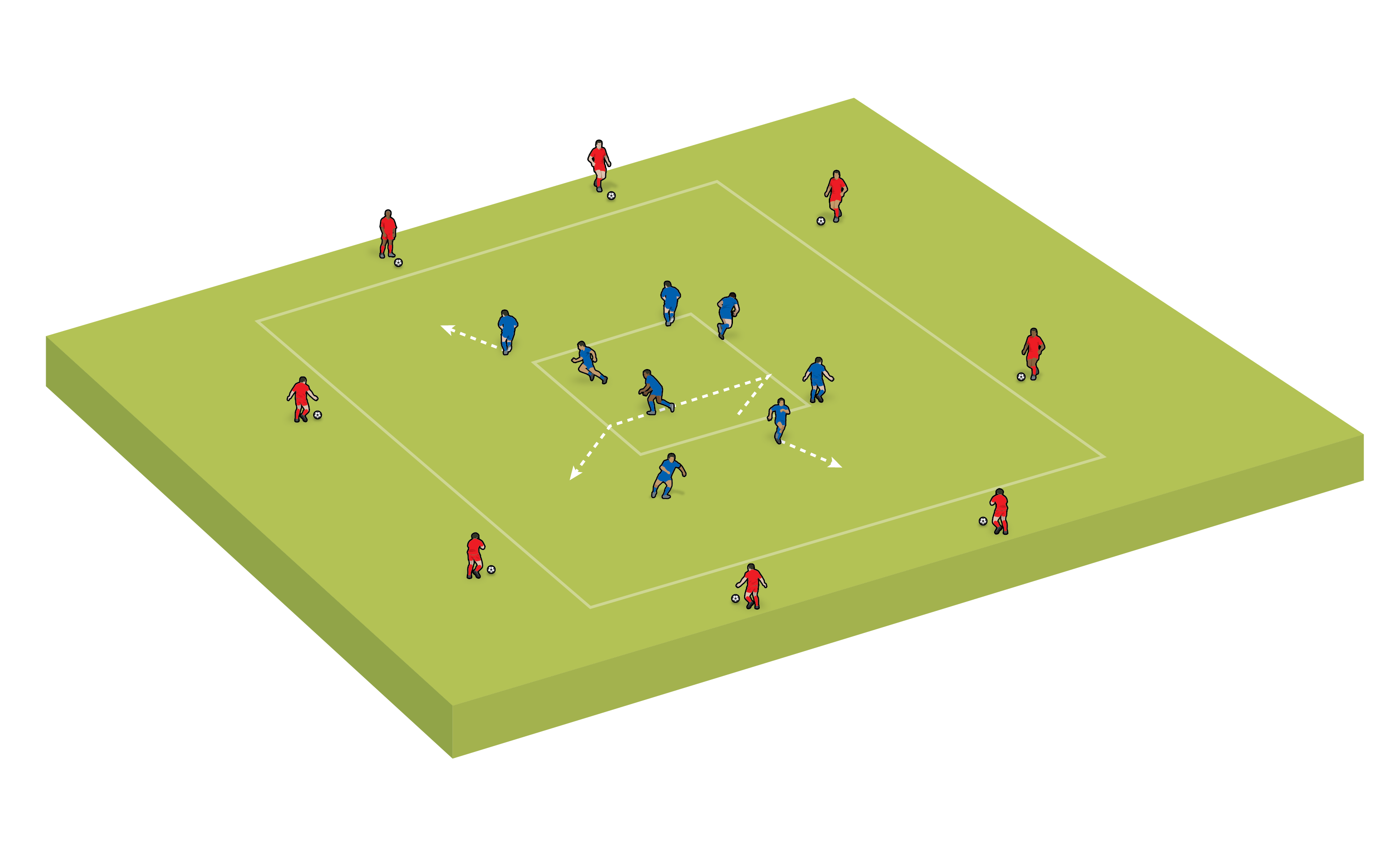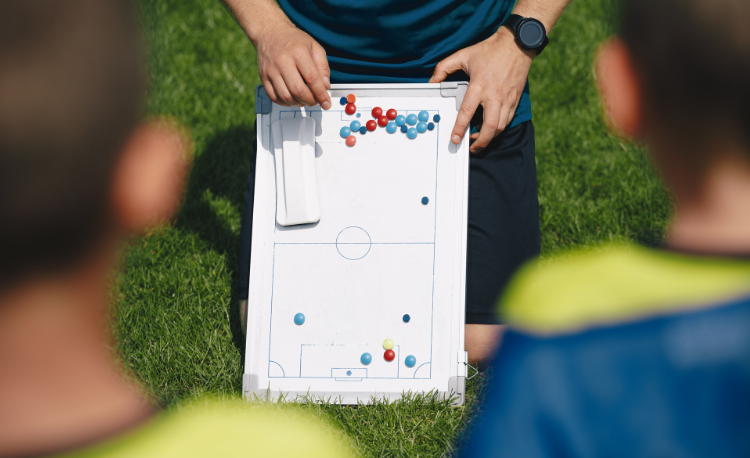Prepare players for the move to nine-a-side
Young players and their coaches face challenges in stepping up from seven-a-side. Carl Wild discusses how to navigate them and what pitfalls to avoid.
The changes players will experience when they transfer from playing seven-a-side to nine-a-side are arguably the most challenging they will come across during their developmental journey.
Not only will they have to cope with the extra number of players and both a larger playing area and goals, they will also have to manage the additional challenge of the extra laws (including offside) and the greater emphasis that is placed on tactical understanding.
To help the players through these changes, we can provide them with support during training and matches.
This can start while they are still playing seven-a-side and continue throughout the time they play nine-a-side.
Support through training
The most obvious time we can support the players is during training, introducing them to the new rules they will have to get used to and starting to work on the tactical requirements of the new format.
Add the offside law: Introducing the offside law within practices and training games will support players with their understanding of offside in preparation for the move to nine-a-side.
We can also design or adapt practices to help players understand how the offside law impacts the principles of the game, both in and out of possession.
For example, having a practice where teams win a point by receiving a pass in an end zone can be very effective.
This will only work, however, if the players are only permitted to enter the end zone once the pass has been made.
Essentially, the lines separating the main area and the end zones act as offside lines.
This simple practice, which I have reproduced on page five for coaches to follow, will help your players develop an understanding of how to time their off-the-ball runs, plus the weight and placement of passes required to break the offside trap.
Split the pitch into areas or zones: Another effective strategy is to split the pitch into areas or zones, which can be used as ‘guides’ for the players or to implement specific rules.
If we split the pitch horizontally into four, for example, we can say to the players that when their team is out of possession, they should not be in more than two of the quarters.
"During training, introduce players to the new rules they will have to get used to..."
This simple challenge helps players to understand the need to remain compact as a team and can even be used to introduce a specific strategy such as a high press or low block.
If we split the pitch vertically, we can say that if the ball is in a wide channel, there should be no players in the opposite wide channel; or if the ball is in one of the two central channels, that there shouldn’t be any players in the wide channels.
We can also use this for the team in possession, challenging players to have at least one player in all four channels.
Support through matches
Don’t move to nine-a-side too soon: Many coaches will prepare their team for the change in format by arranging nine-a-side exhibition games or tournaments before they are meant to make the transition.
However, this is not really preparing them for the new format - it is just getting them to play it earlier.
We need to be careful when we are doing this. We should not introduce the new format too early, as the whole purpose of having different formats is that each one has been identified as being the most suitable for the development of that particular age group.
Once a team starts playing a new format of the game, it is likely they will not return to playing the previous one. Therefore, we should not be in a rush to get them playing nine-a-side. Instead, we should be maximising the time they have playing seven-a-side.

Introduce in-game challenges to replicate principles of nine-a-side: You can prepare players for nine-a-side while they are still playing seven-a-side. It just takes a bit of bravery from the coach.
For instance, because there are no offsides in seven-a-side, attacking players often take up a position that is not realistic to the nine-a-side or full version of the game.
The knock-on effect of that is we then encourage players to defend in a way that goes against the defensive principles of the game.
If an attacker stands near to the goal, we will probably want a defender to position themselves close to them. But this makes it difficult for the team to be compact in its shape and for players to provide cover and support. In nine-a-side and 11-a-side, this could also mean someone is being played onside.
To combat this, as the team starts to enter the final stages of playing seven-a-side, we could provide in-game challenges.
One such example might be that, when the ball is in the opposition half, all of our players must be in that half as well, no matter where any of their opponents stand.
This will help the team to be compact and start to ignore opposition players in an offside position. It could also encourage our goalkeeper to start further up the pitch and the team to start to understand the tactic of winning the ball higher up.
Play a seven-a-side game with offsides: We could even arrange with the coach of the other team to play offsides within a seven-a-side fixture, perhaps with the rules only applied to players who are ‘clearly’ offside.
Alternatively, we could provide players with individual challenges relevant to their playing position and show how the role may differ when they move to nine-a-side.
For example, we may challenge a central midfielder to always be in a position to support whichever team-mate has the ball
Conclusion
The key to all this is that we do not jump straight from one format of the game to the next.
If we can make it a more gradual process, it becomes easier for players to learn and understand new information.
When helping players in their transition to nine-a-side, we need to identify the aspects of the game that are different to the seven-a-side format, and then provide them with a range of environments that gives them an opportunity to practice these differences while we guide and support their learning.
The main thing to remember throughout this transition process is the need for patience.
Moving from seven-a-side to nine-a-side is a significant step, and players will need time to get to grips with it.
takeaways: moving to nine-a-side soccer
- Do not move the players into the nine-a-side format too early
- Remember, it is not just the offside law which is different. We need to help players cope with a greater emphasis on tactical understanding
- Use individual and team challenges during matches that are linked to the requirements of nine-a-side soccer
- Gradually add changes during games. For example, introduce offside while they are still playing seven-a-side
- Use practices that provide the players with an opportunity to explore the differences between the two formats
- Split the pitch into zones during training to provide players with guidelines of where they should be positioned, both with and without the ball.
Related Files
Newsletter Sign Up
Coaches Testimonials

Gerald Kearney, Downtown Las Vegas Soccer Club

Paul Butler, Florida, USA

Rick Shields, Springboro, USA

Tony Green, Pierrefonds Titans, Quebec, Canada
Subscribe Today
Discover the simple way to become a more effective, more successful soccer coach
In a recent survey 89% of subscribers said Soccer Coach Weekly makes them more confident, 91% said Soccer Coach Weekly makes them a more effective coach and 93% said Soccer Coach Weekly makes them more inspired.
*includes 3 coaching manuals
Get Weekly Inspiration
All the latest techniques and approaches
Soccer Coach Weekly offers proven and easy to use soccer drills, coaching sessions, practice plans, small-sided games, warm-ups, training tips and advice.
We've been at the cutting edge of soccer coaching since we launched in 2007, creating resources for the grassroots youth coach, following best practice from around the world and insights from the professional game.

